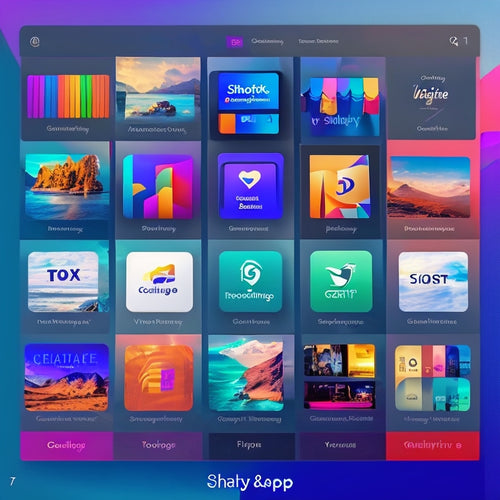
Mastering Course Sales on Shopify: Insider Tips
Share
You're looking to master course sales on Shopify, and it starts with a solid foundation. Set up your store with a theme that resonates with your target audience, and guarantee a seamless user experience. Next, craft engaging course content that showcases your expertise and incorporates interactive modules. To drive conversions, optimize your checkout process, utilize upselling, and focus on customer retention. Deliver exceptional customer experiences through personalized interactions and multichannel support. Finally, set the right price for your course by balancing profitability and customer affordability. Now, get ready to take your course sales to the next level - there's more to explore.
Key Takeaways
• Select a Shopify theme that resonates with your target audience and optimizes for mobile responsiveness to increase conversions.
• Integrate payment gateways like PayPal, Stripe, or Shopify Payments to provide secure transactions and increase purchase likelihood.
• Craft engaging course content that shines with expertise, incorporates interactive modules, and uses real-life examples to boost sales.
• Optimize checkout processes, offer flexible pricing options, and utilize upselling and cross-selling strategies to maximize sales and average order value.
• Analyze performance metrics to identify areas for improvement and adjust pricing strategies to balance profitability and customer affordability.
Setting Up Your Shopify Store
When setting up your Shopify store, start by selecting a theme that mirrors your brand's identity and resonates with your target audience. This will help establish a consistent visual brand and create a positive first impression.
Make sure your theme is optimized for mobile responsiveness and user-friendly navigation to enhance the overall shopping experience.
Next, focus on integrating payment gateways like PayPal, Stripe, or Shopify Payments to provide secure transactions for your customers. This will give them peace of mind and increase the likelihood of completing a purchase.
Crafting Engaging Course Content
To craft engaging course content, you'll need to start by selecting a topic that plays to your strengths and resonates with your target audience, ensuring your expertise shines through in every lesson. This will help you create a sense of authority and build trust with your students.
To take your content to the next level, consider the following:
-
High-quality video production: Invest in good equipment and editing software to create visually appealing videos that hold students' attention.
-
Interactive modules: Incorporate quizzes, discussions, and assignments to encourage active learning and engagement.
-
Real-life examples: Use relatable scenarios to illustrate complex concepts and make them more accessible to your students.
- Storytelling techniques: Share personal anecdotes and experiences to create an emotional connection with your audience.
Optimizing Sales and Conversions
By streamlining your checkout process and offering flexible pricing options, you can greatly boost sales and conversions, ultimately driving revenue growth for your online course business.
Implement conversion optimization strategies, such as minimizing friction points and ensuring a seamless user experience, to maximize sales.
Leverage sales strategies like upselling and cross-selling to increase average order value.
To foster customer retention, focus on engagement techniques like personalized communication and loyalty programs.
Analyze performance metrics to identify areas for improvement and adjust your approach accordingly.
Delivering Exceptional Customer Experience
As you focus on building a loyal customer base, you'll find that delivering exceptional customer experience is crucial to driving long-term success and encouraging repeat business for your online course sales on Shopify.
To achieve this, prioritize customer satisfaction and retention by providing personalized interactions and support.
Here are some key strategies to implement:
-
Respond promptly to customer inquiries to show you value their time and concerns.
-
Offer tailored solutions to address specific pain points and needs.
-
Provide multichannel support to cater to different communication preferences.
- Solicit feedback and act on it to demonstrate your commitment to continuous improvement.
Mastering Course Pricing Strategies
You need to strike the perfect balance between profitability and customer affordability when determining the price of your online courses on Shopify. Conduct a competitive analysis to understand what similar courses are selling for, and identify your unique value proposition. Consider the production costs, expertise, and level of engagement required for each course.
Don't underprice your courses, as it may devalue your expertise, but also avoid overpricing, which can deter customers. By finding the sweet spot, you'll attract customers while maintaining profitability. Use Shopify's course pricing tool or third-party apps to help you set the right price and improve customer satisfaction.
Customizing and Expanding Your Store
With your course content and pricing strategy in place, it's time to focus on customizing your Shopify store to create an immersive brand experience and expand your product offerings to attract a wider customer base. This is where you get to showcase your brand's personality and values.
Here are some essential steps to take:
-
Customize your theme to align with your brand identity and optimize for mobile responsiveness.
-
Diversify your products to cater to a broader audience and increase average order value.
-
Implement strategic growth tactics, such as upselling and cross-selling, to maximize business potential.
- Regularly review and adjust your pricing strategies, checkout processes, and marketing efforts to stay competitive.
Scaling Your Course Business
Now that your store is set up and optimized for sales, it's time to focus on scaling your course business to reach a wider audience and increase revenue.
To achieve strategic growth, you'll need to think about business expansion. This means diversifying your course offerings, exploring new markets, and developing a plan to increase your customer base.
Consider expanding your product line to include complementary items or services that appeal to your target audience. You can also explore partnerships or collaborations to reach new customers.
Remember to regularly review and adjust your pricing strategies, checkout processes, and marketing efforts to stay competitive in the market.
Frequently Asked Questions
Can I Sell Courses on Shopify Without a Physical Product?
You can definitely sell courses on Shopify without a physical product, focusing on digital courses and memberships that provide online learning experiences through platforms like Courses Plus, and utilizing Shopify's features for a seamless sale.
How Do I Protect My Course Content From Piracy and Theft?
"Wrap your course content in a protective shield by implementing robust copyright protection and encryption, then securely deliver it with content watermarking, ensuring your intellectual property remains safe from prying eyes and potential thieves."
Can I Offer Subscription-Based or Recurring Payments for Courses?
You can offer subscription-based or recurring payments for courses by setting up membership plans with flexible payment options, such as monthly or annual subscriptions, to provide customers with convenient and secure access to your course content.
What Are the Tax Implications of Selling Courses on Shopify?
When selling courses on Shopify, you'll need to take into account tax implications, such as sales tax, VAT, and income tax, ensuring you comply with legal considerations and regulations in your region to avoid penalties and fines.
Can I Integrate My Email Marketing Tools With Shopify for Course Promotions?
"You're in luck! You can integrate your email marketing tools with Shopify for course promotions. Simply connect your email service provider to Shopify using marketing automation apps, and automate targeted email campaigns to boost sales and engagement."
Related Posts
-

5 Best Ways to Scale Ecommerce With Online Courses
You're already crushing it in ecommerce, but you want to take it to the next level. You can do just that by leveragin...
-

How Do I Add Product Recommendations on Shopify
The integration of product recommendations on the Shopify platform has gained significant attention due to its poten...
-

Unlocking the Power of Private Shopify Apps
This article explores the advantages and operational capabilities of private Shopify apps. Private apps are construc...


